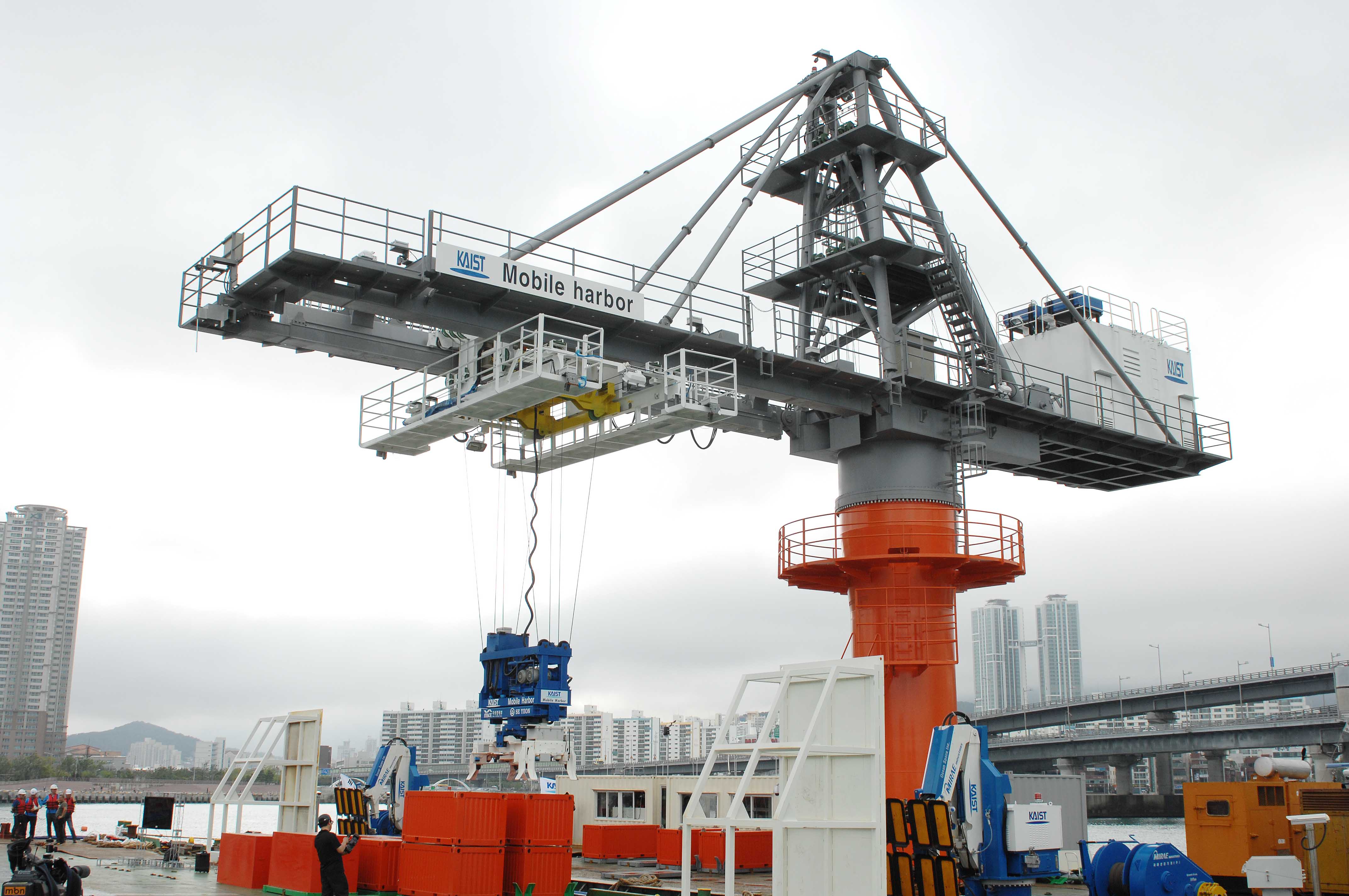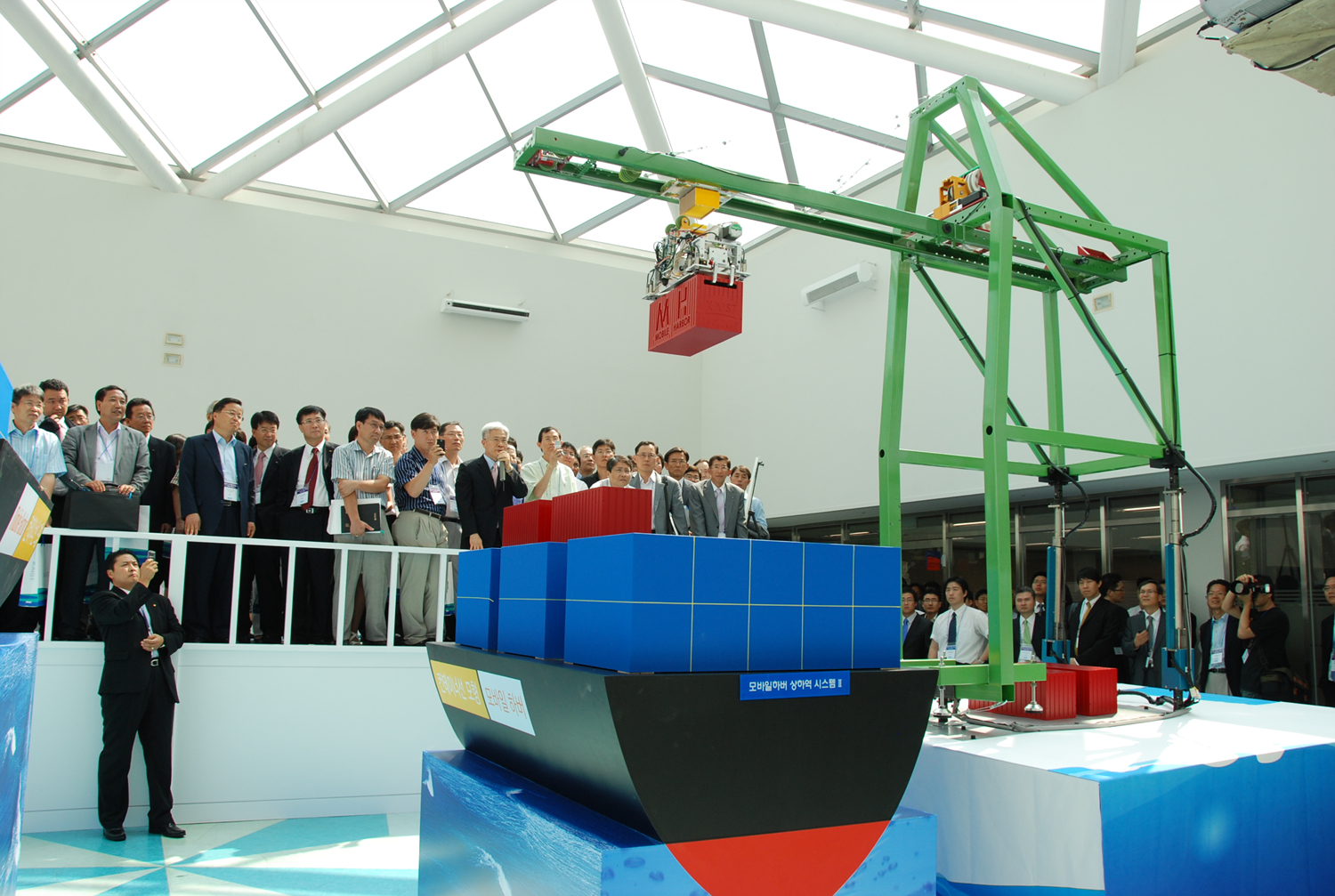Byung-Man+Kwak
-
 KAIST Successfully Demonstrates Mobile Harbor in the Open Sea
Busan, South Korea—Large container ships are no longer required to come into ports to transport cargo, as KAIST has developed an innovative technology that will transform the paradigm of today’s cargo handling operations. A Mobile Harbor is a vessel that carries a large stabilized crane with a smart spreader and multistage trolley system, enabling the loading and unloading of ship cargo on the wavy open sea. Following a successful docking of two vessels at sea in April of this year, KAIST conducted a full scope of Mobile Harbor operations in the inner sea of Busan, South Korea, on June 29, 2011.
Initiated in 2009, the Mobile Harbor (MH) is one of the university’s flagship research projects, which aims to provide a new growth engine that will lead the Korean economy to the next level of advancement, and to develop green technology through multidisciplinary and convergence research. The idea of MH came to light when thinking outside the box (why can’t a harbor go out to meet a ship on voyage and retrieve goods instead of ships coming into the harbor?) to improve problems relating to the current maritime transport system, such as port congestion, environmental issues caused by heavy sea transport, increased demand for supersized container ships, and the need for port construction and expansion.
The essential technology to establish a Mobile Harbor is a docking system and crane system that can overcome the obstacles imposed by the sea, i.e., waves and wind. Connecting two operating vessels of different sizes in the unpredictable and ever-changing environment of the sea was regarded as “impossible” and had never been tried before, but, on April 26, 2011, KAIST successfully demonstrated the technology to moor vessels safely and securely.
The Mobile Harbor has a unique way of mooring vessels that are anchored at sea: its flexibly designed robot arms with a square-shape vacuum suction pad at the tip reach out and attach to the hull of a container ship for docking. Each robot arm is connected to a cable and winch that further add stability to the Mobile Harbor. Foam-filled fenders are placed between the Mobile Harbor and the container ship, thereby maintaining a safe distance to prevent collisions.
The crane system consists of a multistage trolley, smart spreader, and tension controller, all of which provide the crane with functionality and stability to move around cargo containers in the sea. The crane system also has various sensors like cameras and laser scanners, and therefore, it can gauge the movement of the spreader and ships as well as trace a target container in real time. As a result, the spreader, a container grabbing device, is free from the swing motions when lifting and putting down cargo and grabs a target container safely in the wavy open sea.
During today’s at-sea demonstration in Busan, a research team from the KAIST Mobile Harbor Center docked a Mobile Harbor (a barge ship) right next to a container vessel (the other barge ship) and repeated freight transport operations between the two ships, presenting the great potential to commercialize the Mobile Harbor technology.
The project has been implemented in collaboration with industries, research institutes, and universities in such fields as mechanical engineering, robotics, automation engineering, and ocean systems engineering. The demonstration proceeded with a wide range of participants including researchers, engineers, government officials, and entrepreneurs from Korea and around the world.
Byung-Man Kwak, Director of the KAIST Mobile Harbor Center, explained his feelings on the successful demonstration:
“It’s been a remarkable journey to develop a Mobile Harbor from scratch, and I’m genuinely thrilled to showcase what we have accomplished so far. Today’s demonstration of Mobile Harbor’s core technologies will really change the face of our maritime transportation system. We will be able to deliver more goods to global markets and consumers via sea route, not necessarily building more ports or expanding the existing harbors. KAIST’s Mobile Harbor will also significantly cut down the high cost related to overland transportation of cargo and in return, contribute to the reduction of carbon emission.”
The Center has received much interest in possible market migration and broader application of the Mobile Harbor from businesses and organizations, e.g., US Office of Naval Research, King Fahd University of Petroleum and Minerals, Saudi Aramco, POSCO, and the Korean Navy.
2011.07.06 View 18333
KAIST Successfully Demonstrates Mobile Harbor in the Open Sea
Busan, South Korea—Large container ships are no longer required to come into ports to transport cargo, as KAIST has developed an innovative technology that will transform the paradigm of today’s cargo handling operations. A Mobile Harbor is a vessel that carries a large stabilized crane with a smart spreader and multistage trolley system, enabling the loading and unloading of ship cargo on the wavy open sea. Following a successful docking of two vessels at sea in April of this year, KAIST conducted a full scope of Mobile Harbor operations in the inner sea of Busan, South Korea, on June 29, 2011.
Initiated in 2009, the Mobile Harbor (MH) is one of the university’s flagship research projects, which aims to provide a new growth engine that will lead the Korean economy to the next level of advancement, and to develop green technology through multidisciplinary and convergence research. The idea of MH came to light when thinking outside the box (why can’t a harbor go out to meet a ship on voyage and retrieve goods instead of ships coming into the harbor?) to improve problems relating to the current maritime transport system, such as port congestion, environmental issues caused by heavy sea transport, increased demand for supersized container ships, and the need for port construction and expansion.
The essential technology to establish a Mobile Harbor is a docking system and crane system that can overcome the obstacles imposed by the sea, i.e., waves and wind. Connecting two operating vessels of different sizes in the unpredictable and ever-changing environment of the sea was regarded as “impossible” and had never been tried before, but, on April 26, 2011, KAIST successfully demonstrated the technology to moor vessels safely and securely.
The Mobile Harbor has a unique way of mooring vessels that are anchored at sea: its flexibly designed robot arms with a square-shape vacuum suction pad at the tip reach out and attach to the hull of a container ship for docking. Each robot arm is connected to a cable and winch that further add stability to the Mobile Harbor. Foam-filled fenders are placed between the Mobile Harbor and the container ship, thereby maintaining a safe distance to prevent collisions.
The crane system consists of a multistage trolley, smart spreader, and tension controller, all of which provide the crane with functionality and stability to move around cargo containers in the sea. The crane system also has various sensors like cameras and laser scanners, and therefore, it can gauge the movement of the spreader and ships as well as trace a target container in real time. As a result, the spreader, a container grabbing device, is free from the swing motions when lifting and putting down cargo and grabs a target container safely in the wavy open sea.
During today’s at-sea demonstration in Busan, a research team from the KAIST Mobile Harbor Center docked a Mobile Harbor (a barge ship) right next to a container vessel (the other barge ship) and repeated freight transport operations between the two ships, presenting the great potential to commercialize the Mobile Harbor technology.
The project has been implemented in collaboration with industries, research institutes, and universities in such fields as mechanical engineering, robotics, automation engineering, and ocean systems engineering. The demonstration proceeded with a wide range of participants including researchers, engineers, government officials, and entrepreneurs from Korea and around the world.
Byung-Man Kwak, Director of the KAIST Mobile Harbor Center, explained his feelings on the successful demonstration:
“It’s been a remarkable journey to develop a Mobile Harbor from scratch, and I’m genuinely thrilled to showcase what we have accomplished so far. Today’s demonstration of Mobile Harbor’s core technologies will really change the face of our maritime transportation system. We will be able to deliver more goods to global markets and consumers via sea route, not necessarily building more ports or expanding the existing harbors. KAIST’s Mobile Harbor will also significantly cut down the high cost related to overland transportation of cargo and in return, contribute to the reduction of carbon emission.”
The Center has received much interest in possible market migration and broader application of the Mobile Harbor from businesses and organizations, e.g., US Office of Naval Research, King Fahd University of Petroleum and Minerals, Saudi Aramco, POSCO, and the Korean Navy.
2011.07.06 View 18333 -
 KAIST's Mobile Harbor Program Attracts Two Corporate Investments
KAIST-developed Mobile Harbor Program has attracted investments from Korea"s two big-name industrial corporations, university authorities said on Monday (Oct. 19).
KAIST has recently signed an agreement with Hyundai Wia Corp., a machine parts supplier, to collaborate in the researches of the mobile harbor programs and commercialization. Under the agreement, Hyundai WIA will invest a total of 7.5 billion won in the program for two years starting from January 2010.
KAIST has also received a letter of intent from the Daewoo Shipbuilding & Marine Engineering Co. on investing 20 billion won in the commercialization of the project.
The Mobile Harbor Program is designed to create mobile units that can go out to the ship which are anchored off-shore and unload the cargo and take it to where it is needed. It is aimed at overcoming the shortcomings of the current maritime container transportation systems. Container ships are getting larger and larger, requiring deep waters, large and complex loading and unloading systems, and major investments in facilities.
Prof. Byung-Man Kwak, leader of the program"s R&D team, said: "With the investment from two global industrial companies, the program has gained a crucial momentum. The development of the program is expected to help Korea to become a global leader in marine transportation and maintain its supremacy in shipbuilding."
2009.10.20 View 18316
KAIST's Mobile Harbor Program Attracts Two Corporate Investments
KAIST-developed Mobile Harbor Program has attracted investments from Korea"s two big-name industrial corporations, university authorities said on Monday (Oct. 19).
KAIST has recently signed an agreement with Hyundai Wia Corp., a machine parts supplier, to collaborate in the researches of the mobile harbor programs and commercialization. Under the agreement, Hyundai WIA will invest a total of 7.5 billion won in the program for two years starting from January 2010.
KAIST has also received a letter of intent from the Daewoo Shipbuilding & Marine Engineering Co. on investing 20 billion won in the commercialization of the project.
The Mobile Harbor Program is designed to create mobile units that can go out to the ship which are anchored off-shore and unload the cargo and take it to where it is needed. It is aimed at overcoming the shortcomings of the current maritime container transportation systems. Container ships are getting larger and larger, requiring deep waters, large and complex loading and unloading systems, and major investments in facilities.
Prof. Byung-Man Kwak, leader of the program"s R&D team, said: "With the investment from two global industrial companies, the program has gained a crucial momentum. The development of the program is expected to help Korea to become a global leader in marine transportation and maintain its supremacy in shipbuilding."
2009.10.20 View 18316